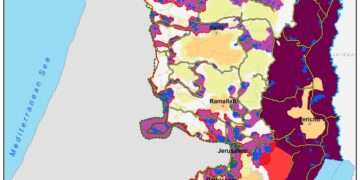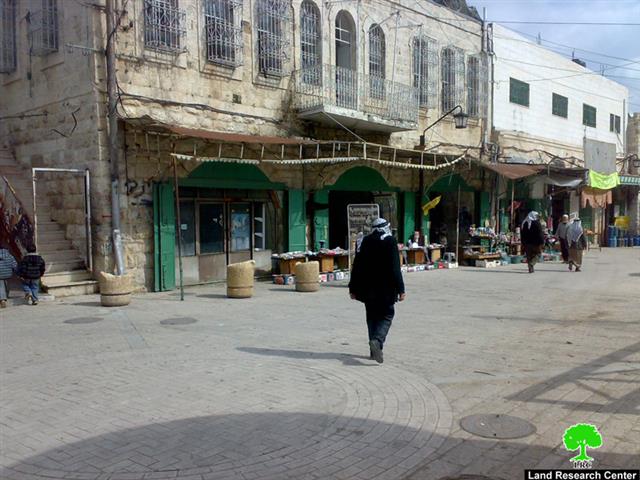On the 31
st of January 2010, the cornerstone for a new Jewish neighborhood was placed in East Jerusalem city, in a ceremony attended by some Israeli Knesset members, Jerusalem councilmen, as well as the former GOP (Grand Old Party / Republican Party)
[ and presidential candidate Mike Huckabee. Initial construction of the new neighborhood which is called Beit Orot is located next to Beit Orot religious school (Yeshiva in Hebrew) on Mount Scopus
in Jerusalem city, near the Augusta Victoria Hospital. It is worth mentioning that the new neighborhood, which is financed by the Jewish-American millionaire, Irwing Moskowitz
, called for the construction of 24 new colonial units in the area and has been given the green light on the 5
th of January 2010 by Jerusalem Municipality’s Planning and Construction Committee.
During the Ceremony, the former GOP and possible future presidential candidate Mike Huckabee
stated:
‘As an American, it is inconceivable that there is even a question about whether a Jew may or may not live in various parts of Jerusalem’. Furthermore, Israeli Science Minister Rabbi Prof. Daniel Herskovitz
, head of the ‘Jewish Home’ political party said:
‘Jewish construction in Jerusalem does not block peace; on the contrary, it brings peace closer. The more construction there is, the more peace there will be. And therefore this neighborhood is just a cornerstone – a model for the renewal of building in Jerusalem’. Also Deputy Mayor David Harari, from the National Religious Party said that:
‘The housing units to be built here are just the beginning. We have already been having discussions about turning it into a large neighborhood’.
On the other hand, the Israeli Municipality of Jerusalem issued on the 7th of February 2011 plans for building 13 colonial units in Ash Sheikh Jarrah neighborhood in Jerusalem city where these units will come in the form of two buildings where the first building will include 10 colonial units and the second building will include two units. The units are planned to be built in the western part of the neighborhood and will result in the evacuation of Palestinian families living in the neighborhood.
It is worth mentioning that Al Shiekh Jarrah Neighborhood is listed among the sites targeted by Israeli settlers’ organization in Jerusalem city where on August 20, 2011, the families of Al Ghawi and Al Hanoun families were forcibly evicted from their homes under the pretext that these houses are owned by Jewish organizations, while the eviction process comes to fulfill the Israeli dream in the area, which is to establish another Jewish neighborhood in occupied East Jerusalem through the evacuation and demolition of 28 Palestinian houses in the neighborhood of Ash Sheikh Jarrah
. Also on the 9
th of January of 2011, the Israeli Occupation bulldozers demolished the Shepherd Hotel to make way for building 20 colonial units in the area (out of 390 units). The demolition of the hotel came under the pretext that the hotel is owned by the Jewish-American millionaire Irwing Moskowitz
.
Soon after the 1967 occupation of the West Bank including East Jerusalem and the Gaza strip, the Israeli authorities undertook serious measures in the Palestinian territory with particular focus on Jerusalem. The IO authorities first expanded the Jerusalem Municipality borders from 6.5 km² to 71 km² on the expanse of lands of East Jerusalem communities and went over to include some lands from Bethlehem Governorate. In addition, the IO authorities began the settlement program to consolidate the control over the land. Table 1 shows the settlements that were established in east Jerusalem city over the years along with their population and area:
|
Table 1: Israeli Settlements established in Occupied East Jerusalem since 1967
|
|
|
No.
|
Settlement
|
Governorate
|
Population
|
Area (dunum)
|
|
1.
|
Gilo
|
Bethlehem
|
40000
|
2738
|
|
2.
|
Har Homa (Abu Ghneim Mountain)
|
Bethlehem
|
7236
|
2205
|
|
3.
|
Har Gilo
|
Bethlehem
|
479
|
414
|
|
4.
|
Gi’vat HaMatos
|
Bethlehem
|
309
|
288
|
|
5.
|
Mamila
|
Jerusalem
|
NA
|
53
|
|
6.
|
Jewish Quarter
|
Jerusalem
|
2555
|
136
|
|
7.
|
Settler Houses in Old City
|
Jerusalem
|
2700
|
20
|
|
8.
|
Atarot Industrial Zone
|
Jerusalem
|
Industrial settlement
|
1378
|
|
9.
|
East Telpiot
|
Jerusalem
|
12241
|
1829
|
|
10.
|
Giv’at Shappira
|
Jerusalem
|
6897
|
688
|
|
11.
|
Hebrew University (Har HaTzofim)
|
Jerusalem
|
NA
|
957
|
|
12.
|
Neve Ya’akov
|
Jerusalem
|
20230
|
1241
|
|
13.
|
Pisgat Ze’ev
|
Jerusalem
|
41882
|
1546
|
|
14.
|
Ramat Eshkol
|
Jerusalem
|
6176
|
1118
|
|
15.
|
Ras Al A’mud (Ma’ale Ha Zeitim)
|
Jerusalem
|
320
|
11
|
|
16.
|
Pisgat Amir
|
Jerusalem
|
Combined population with Pisgat Ze’ev
|
2516
|
|
17.
|
Rekhes Shu’fat (Ramat Shlomo)
|
Jerusalem
|
14911
|
1625
|
|
18.
|
Ramot
|
Jerusalem
|
41448
|
3383
|
|
Total
|
197384
|
22146
|
Source: Applied Resaerch Institute – Jerusalem 2011
At the Annapolis Conference, which was held on November 27, 2007 in
Annapolis,
Maryland, in the United States, Israel and the National Palestinian Authority renewed their respective commitments under the Road Map. The main points of the Israeli State obligations is the Freeze of Settlement activity ‘including natural growth of settlements’, and the immediate dismantle of settlements’ outposts established after March 2001. Despite Israel’s commitment during the Annapolis conference to freeze all settlements’ activities, construction has continued and almost doubled in most of Israeli settlements and outposts in the West Bank especially on those located west of the Israeli Segregation Wall (including Jerusalem area) and the Jordan Valley; for more information, check the analysis conducted by the Applied Research Institute – Jerusalem (ARIJ)
‘Israeli Settlements dramatically expand in the Occupied West Bank between the years 1996 & 2007 ‘, and the case ‘Israeli settlements in the Occupied West Bank expand during the 10-month settlement construction freeze‘ which show the expansion that took place in Israeli settlements in the Occupied West Bank during the years 1996 and 2010. ‘, and the case which show the expansion that took place in Israeli settlements in the Occupied West Bank during the years 1996 and 2010.
Since Annapolis, the late Israeli Prime Minister Ehud Olmert and other Israeli officials have repeatedly declared that Israel would not implement a genuine settlement freeze. Among other things, PM Olmert has said that Israel would continue building in settlements in and around East Jerusalem, in the major Israeli settlement blocs that surround Jerusalem city (Ma’ale Adumim settlement bloc in the east, Giv’at Ze’ev Settlement bloc in the north and Gush Etzion settlement bloc in the south) to fulfill the Israeli dream of
‘Greater Jerusalem’ thus effectively negating the very purpose of settlements freeze. Map 1 thus effectively negating the very purpose of settlements freeze.
The late U.S. Secretary of State Condoleezza Rice declared during the Annapolis conference that ‘The United States doesn’t make a distinction” between settlement activity in East Jerusalem and the rest of the West Bank, Israeli officials continue to make unilateral exemptions to their settlement freeze obligations’
.
To conclude:-
Israeli settlements violate the international humanitarian law- the Fourth Geneva Convention Relative to the Protection of Civilian Persons in a Time of War- and The Hague Conventions and numerous United Nations Security Council and General Assembly Resolutions:-
-
Article 46 of the Hague Convention prohibits confiscation of private property in occupied territory. Article 55 of the same Hague Convention stipulates ‘The occupying state shall be regarded only as administrator and usufructuary of public buildings, real estate, forests, and agricultural estates belonging to the hostile State, and situated in the occupied country. It must safeguard the capital of these properties, and administer them in accordance with the rules of usufruct’.
-
Article 49, paragraph 6 of the Fourth Geneva Convention explicitly stipulates that ‘The occupying power shall not deport or transfer parts of its own civilian population into the territory it occupies’.
-
UN Security Council Resolution 465 (1980-unanimously adopted) made it clear that ‘Israel’s policy and practices of settling parts of its population and new immigrants in the Occupied Territories constitutes a serious obstruction to achieving a comprehensive, just and lasting peace in the Middle East’. The Security Council called upon Israel to ‘dismantle the existing settlements and in particular to cease, on an urgent basis, the establishment, construction or planning of settlements in the Arab territories occupied since 1967, including Jerusalem’.
-
The 2004 ruling of the International Court of Justice in The Hague declared that ‘Israeli settlements in the Occupied Palestinian Territory, including East Jerusalem, are illegal and an obstacle to peace and to economic and social development’.
::::::::::::
[2] Har Hatzofim in Hebrew and Jabal Al Masharif in Arabic














